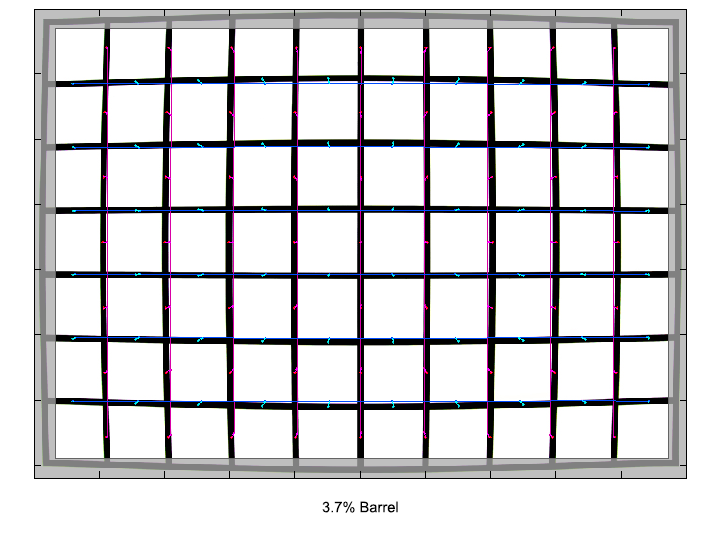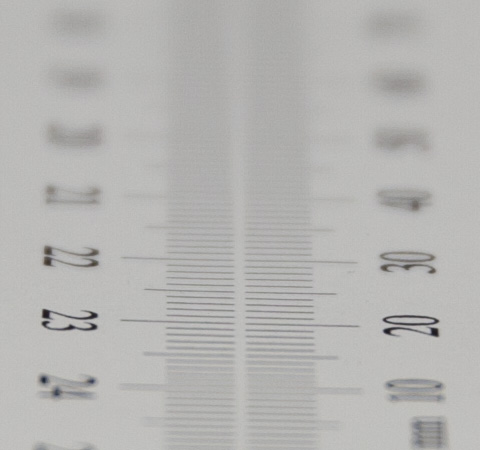|
Page 2 of 3

Distortion
The distortion characteristic is average for a lens in this class. At the critical wide end (24mm) it produces a very high albeit not extreme amount barrel distortion of 3.7%. At 35mm it already switches to a pincushion type distortion, however at a rather low level of just 0.4%. At higher focal lengths, the pincushion distortion remains more or less on the same and slightly pronounced level of around 1.6 to 1.7%.
To be fair, this is comparable to the behavior of the Nikkor AF-S 24-120 f/4 VR, even though the absolut numbers at the upper zoom range are a little lower with the Sigma.
|
Move the mouse cursor over the focal length text marks below to observe the respective distortion
|
| 24mm |
35mm |
50mm |
70mm |
105mm |
|

|
The chart above has a real-world size of about 120x80cm.
Vignetting
This is a lens test based on a full format sensor and wide to standard zoom lenses tend to have difficulties in terms of vignetting. The Sigma 24-105mm f/4 DG OS is no exception to the rule here.
At 24mm we can observe a light falloff reaching almost ~2EV (f-stops). It remains quite pronounced at f/5.6 and it's still fairly high at f/8 and f/11 (0.9EV). The issue is reduced at 35mm but increases again towards the long end (1.7EV at f/4) where the effect is usually more critical and also more disturbing regarding the common usage patterns.
Given the immense size of the front element this is a bit disappointing.
We're performing our vignetting analysis based on
(uncorrected) JPEGs straight from the camera. The JPG engine of the Nikon D3x features a rather flat
gradation curve, thus has a moderate contrast characteristic, resulting in comparatively low vignetting figures - the
corresponding Canon figures are roughly 40% higher due to the more
aggressive default contrast setting.

MTF (resolution)
The Sigma lens produced decent resolution figures in the MTF lab. The center performance is excellent if not stunning at large to medium aperture settings. However, the borders/corners can't quite follow up.
In the lower range the borders are very good and the corners can still reach good to very good results. It is worth to note that at 24mm, there's also a rather sharp drop just beyond our corner reading point.
In the upper zoom range the center quality is slightly reduced but the general characteristic remains intact here. The field curvature is not an issue beyond the wide end.
Please note that the MTF results are not directly comparable across the different systems!
Below is a simplified summary of the formal findings. The chart shows line widths
per picture height (LW/PH) which can be taken as a measure for sharpness.
If you want to know more about the MTF50 figures you may check out the corresponding
Imatest Explanations

Chromatic Aberrations (CAs)
Lateral chromatic aberrations (color shadows at harsh contrast transitions) are comparatively moderate with a peak of 1.6px at 24mm f/4. The CAs decrease when stopping down and they aren't quite as pronounced in the medium to upper focal length range.

Bokeh
Normally we don't formally test the bokeh quality of "slow" lenses such as the Sigma 24-105mm f/4 DG HSM OS | A but given its professional nature, this is relevant for many customers.
Out-of-focus highlights show a near-circular shape at large aperture settings but the inner zone of these "discs" is slightly busy/nervous and there's a bit of an outlining effect. The circular shape remains mostly intact till about f/8 (tested at 105mm). As usual you have to live with a very pronounced deterioration of the disc shape (cat's eyes) towards the image borders/corners - this is a vignetting effect that can be improved by stopping down.
 The quality of the blur in the focus transition zone is very good for a standard zoom lens. It's smooth in the background and just slightly more nervous in the less critical foreground.
The quality of the blur in the focus transition zone is very good for a standard zoom lens. It's smooth in the background and just slightly more nervous in the less critical foreground.

Bokeh Fringing
Bokeh fringing isn't really a substantial issue in slow speed lenses anymore. The Sigma 24-105mm f/4 DG HSM OS | A shows very marginal traces at f/4 but they are gone at f/5.6.
Please note that this test also reveals a focus shift upon stopping down - the focus hot-spot moves to the background.
|
Move the mouse cursor over the f-stop marks below to observe the respective LoCAs
|
| f/4.0 |
f/5.6 |
f/8.0 |
|

|
|